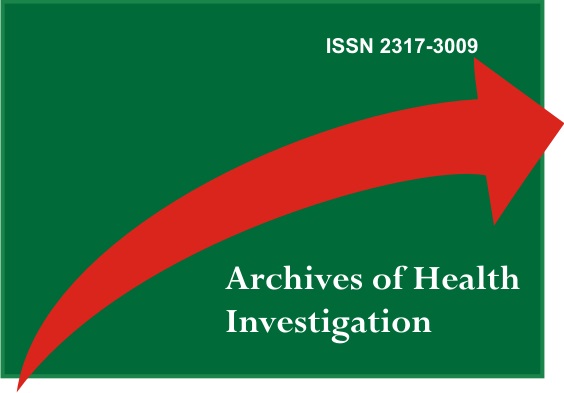Relação entre o forame apical e o ápice radicular em dentes anteriores superiores humanos
DOI:
https://doi.org/10.21270/archi.v10i5.4939Palavras-chave:
Endodontia, Anatomia, Ápice DentárioResumo
Introdução: A anatomia da região mais apical do dente se reveste de bastante importância, pois é a partir dessa região que podemos definir o comprimento para execução de todas as etapas da terapia endodôntica. Objetivo: aferir, em condição ex vivo, a distância entre o forame principal e o vértice radicular de incisivos centrais, incisivos laterais e caninos superiores humanos, verificando a taxa de coincidência entre estas estruturas anatômicas, bem como a face de exteriorização do forame principal. Material e Método: 134 dentes anteriores superiores humanos, tiveram seus acessos realizados e a patência foraminal estabelecida com instrumentos tipo K #10. Os mesmos foram divididos em três grupos, em função do grupamento dentário pertencente: incisivo central (n=52), incisivo lateral (n=46) e canino (n=36), numerados de forma aleatória e fotografados com câmera digital acoplada ao Microscópio Digital, permitindo medir a extensão entre o forame apical e o vértice radicular. Resultados: as medidas médias e de desvio padrão dos comprimentos obtidas para cada grupo foram: 0,63 e 0,27 (incisivo central), 0,66 mm e 0,27 (incisivo lateral) e, 0,87 mm e 0,41 (canino). A taxa de coincidência forame/ápice para a amostra foi de 19,4%, sendo maior para os incisivos laterais (23,9%) e menor para os caninos (13,9%). A face palatina foi onde ocorreu a maior frequência de exteriorização do forame principal. Conclusão: os resultados desta pesquisa apontam para uma baixa taxa de coincidência forame-ápice em dentes anteriores superiores humanos, sendo a distância entre as estruturas anatômicas e face de exteriorização extremamente variável.
Downloads
Referências
Basmadjian-Charles CL, Farge P, Bourgeois DM, Lebrun T. Factors influencing the long-term results of endodontic treatment: a review of the literature. Int Dent J. 2002;52(2):81-6.
Ng YL, Mann V, Rahbaran S, Lewsey J, Gulabivala K. Outcome of primary root canal treatment: systematic review of the literature–part 1. Effects of study characteristics on probability of success. Int Endod J. 2007;40(12):921-39.
Silva MHC, Oliveira PY, Lima CO, Lacerda MFLS, Girelli CFM, Avelar RAD, Brandão RGP. Importance of location of root channels during endodontic treatment. Braz J Health Rev. 2019;2(1):154-61.
Ricucci D, Langeland K. Apical limit of root canal instrumentation and obturation, part 2. A histological study. Int Endod J. 1998;31(6):394-409.
Wu MK, Wesselink PR, Walton RE. Apical terminus location of root canal treatment procedures. Oral Surg Oral Med Oral Pathol Oral Radiol Endod. 2000;89(1):99-103.
Burgel MO, Borba MG. SEM analysis of apical anatomy of mandibular premolars. RFO UPF. 2011;16(1):49-53.
Zani M, Ribeiro FC, Azeredo RA, Barros MGN, Schneider CM, Barroso JM. In vitro analysis of the canal treated teeth in jaws CT, operating microscope and photographs. Braz J Health Res. 2010;12(3):11-6.
Mancilha FAB, Vance R, Habitante SM, Simões S. Comparative study of internal anatomy of the anomalous teeth between radiographic techniques and clearing method. SOTAU Rev Virtual Odontol. 2008;5:22-9.
Burch JG, Hulen S. The relationship of the apical foramen to the anatomic apex of the tooth root. Oral Surg Oral Med Oral Pathol. 1972;34(2):262-68.
Soares JA, Silveira FF, Nunes E, Jham B, Borges EF. In vitro analysis of the distance from the main foramen to the radiographic vertex of the anterior teeth. Arq Odontol. 2005;41(3):215-25.
Souza RA, Dantas JCP, Colombo S, Lago M, Figueiredo JAP, Pécora JD. Location of the apical foramen and its relationship with foraminal file size. Dent Press Endod. 2011;1:64-8.
Borin AC, Pereira KFS, Verardo LBJ, Schweich LC, Arashiro FN, Tomazinho LF. Distance from apex to foramen and the correlation with radio-graphic odontometry method. Rev UNINGÁ. 2016;47(1):45-9.
Brito LF, Nogueira SJS, Ferreira CM, Gomes FA, Sousa BC. Prevalence of major apical foramen mismatching the root apex in root canals of human permanent teet. RSBO. 2016;13(3):188-93.
Azeredo RA, Trindade FZ, Rédua RB, De Paula VGG, Pimenta VM, Regiani LR, Lacerda LM, De Martin G. Lateral upper incisor radicular canal system study, using macroscopic cuts and clarifying technique. UFES Rev Odontol. 2005;7(1):55-62.
Martos J, Ferrer-Luque CM, González-Rodríguez MP, Castro LA. Topographical evaluation of the major apical foramen in permanent human teeth. Int Endod J. 2008;42(4):329-34.
Alothmani OS, Chandler NP, Friedlander LT. The anatomy of the root apex: A review and clinical considerations in endodontics. Saudi Endod J. 2013;3(1):1.
Assumpção TS, Bramante CM, Moraes IG, Garcia RB, Bernardileni N. Avaliação de Foramina Acessórios com o Uso do Microscópio Clínico e Electrónico de Varredura. Rev Port Estomatol Med Dent Cir Maxilofac. 2009;50(4):215-19.
Salonski CC, Costa EM, Lopes HL, Deonizio MD, Westphalen VPD, Neto UXS, Fariniuk LF. Evaluation of apical foramen in canine human teeth. RSBO. 2004;1(1):13-6.
Leal PM, Gomes RTMC. Comparative analysis of different odontometry methods. Arch Health Invest. 2019;8(2):85-90.
Souza RA, Dantas JCP, Colombo S, Lago M, Figueiredo JAP, Pécora JD. Relationship between the apical limit of root canal filling and repair. Endodontic Practice. 2018:12-23.


